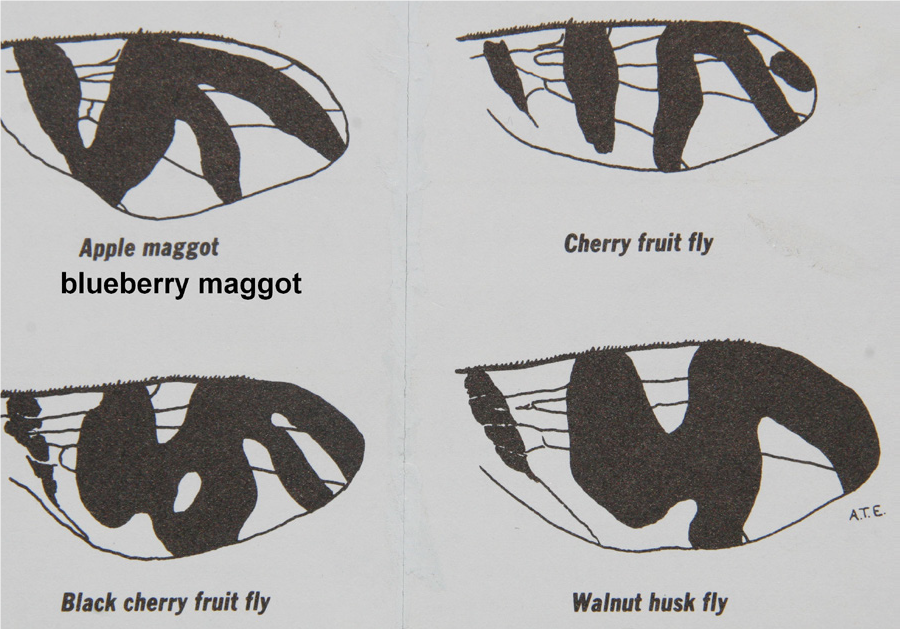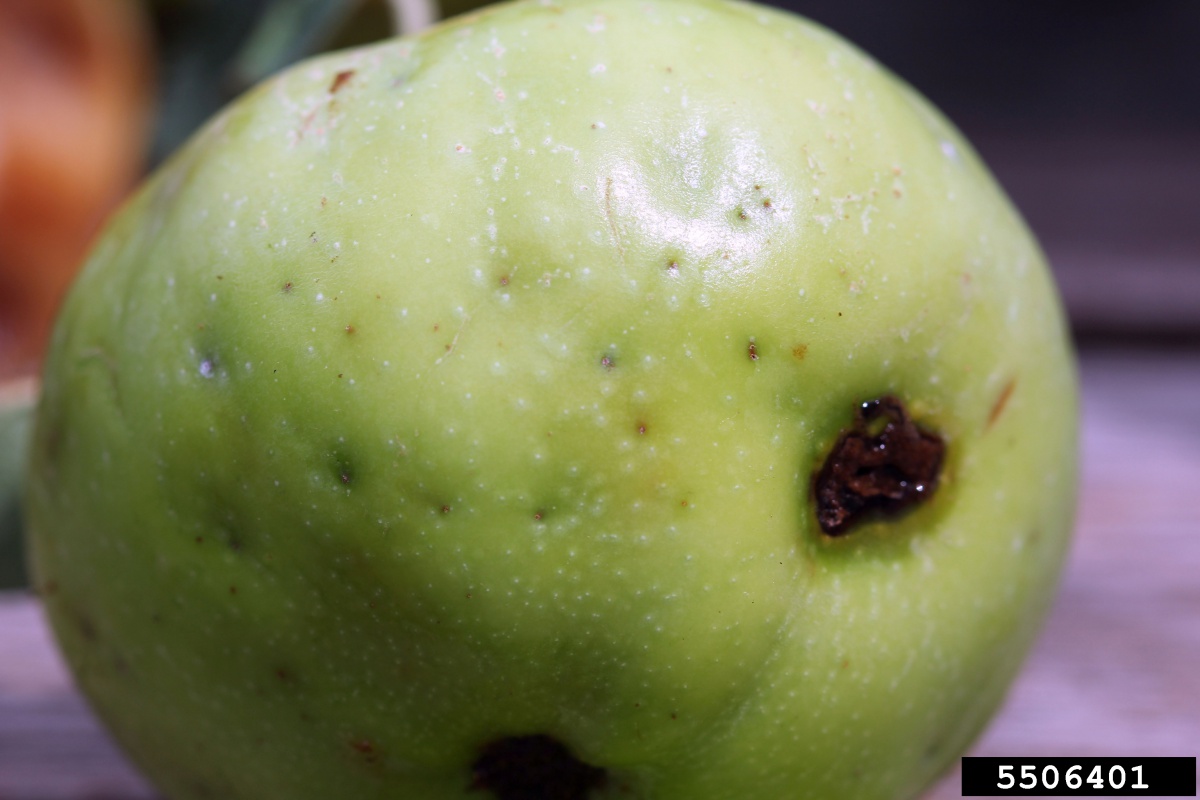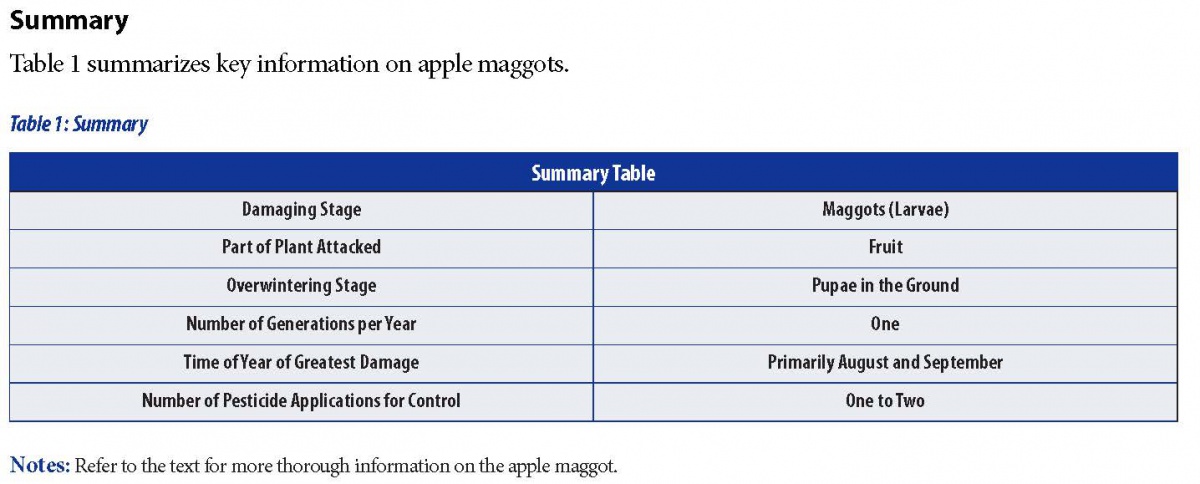The apple maggot (Rhagoletis pomonella) is one of the most important economic insect pests of apples in New Hampshire. This native insect is also known as the “railroad worm.” It is a northern pest of apples, ranging from the Dakotas to Arkansas and Canada. It has invaded parts of California, Oregon, Washington, and Utah. If left unchecked, the apple maggot can infect 100% of a season’s apple crop. In addition to apples, it commonly infests hawthorns and crabapples. In Utah and in parts of Wisconsin and Michigan, it also attacks cherries.
Description
The adult apple maggot is slightly smaller than a house fly and is black with white bands on the abdomen. Females have four abdominal bands and a pointed abdomen while males have three white bands on their blunt abdomen. The wings of both sexes have a pattern of zigzag black bands. There is a white dot in the middle of the back, close to the base of the wings. Positive identification of this species is assured by seeing this prominent spot and the characteristic pattern of wing bands. Other closely related flies have the white spot, but different patterns of black wing bands.
Females lay their eggs singly in tiny punctures that are difficult to see on the apple skin. The immature stage is a white, legless maggot which tunnels through the fruit.

The wing band pattern is distinctive, and can be recognized at a glance. Credit:
Alan Eaton.
Life Cycle
There is only one generation of apple maggot per year in New Hampshire. Apple maggots overwinter as pupae, 1-6” deep in the soil. Adults start emerging early in July, but emergence is greatly stretched out over time. Time of first emergence varies from one spot to the next, and is affected by soil type, soil moisture, shading, and other factors. Adults feed on honeydew lapped from leaves. Egg laying does not occur until 8-10 days after the fly has emerged. The eggs are deposited in tiny punctures in the skin of developing apples. They hatch 5-10 days later and the maggots immediately begin to bore throughout the apple. The maggot feeding resembles a complex system of railroads. That is why the name “railroad worm” applies to the apple maggot. When the apples drop to the ground, the maggots develop rapidly and enter the soil where they pupate.


Cranshaw, Colorado State University, Bugwood.org.
Management
IPM Strategies:
- Sanitation - Sanitation can help reduce populations. Pick up and remove from the orchard any apples that fall during the growing season and after harvest.
- Monitoring - Sticky traps are often used to monitor apple maggot presence in the orchard. Traps capture the adults that attempt to land on them. These traps are red spheres coated with tanglefoot and may or may not contain a scent lure. If you do not use a scent lure, spray for apple maggots when you catch an average of one apple maggot fly per trap. If you use a scent lure, wait until you have caught five apple maggot flies per trap.
- Chemical Control - Apple maggots are easy to control with insecticides. Recent research on their behavior and survival indicates that most commercial growers need not apply more than two well-timed sprays. Some growers will only need one. Guidelines for chemical controls used on apple maggot can be found in the annually revised New England Tree Fruit Management Guide. Consult your county Agricultural Field Specialist for specific recommendations.
Guidelines for chemical controls used on apple maggot can be found in the annually revised New England Tree Fruit Management Guide. Consult your county Agricultural Field Specialist for specific recommendations.



wounds on apple. Credits: Whitney Cranshaw, Colorado State University,
Bugwood.org.

Stop! Read the label on every pesticide container each time before using the material. Pesticides must be applied only as directed on the label to be in compliance with the law. All pesticides listed in this publication are contingent upon continued registration. Contact the Division of Pesticide Control at (603) 271-3550 to check registration status. Dispose of empty containers safely, according to New Hampshire regulations.
Download the resource for the complete factsheet.

